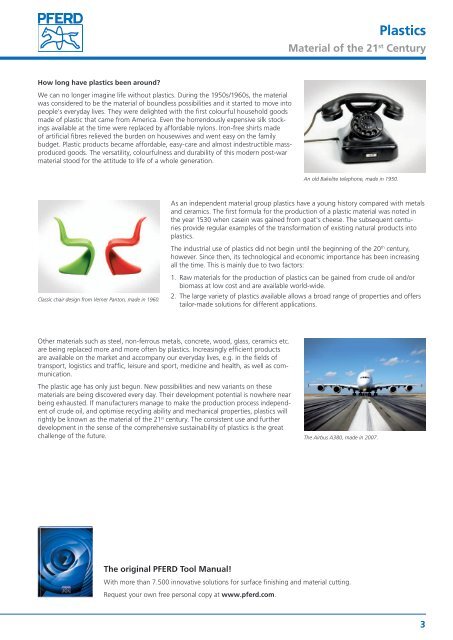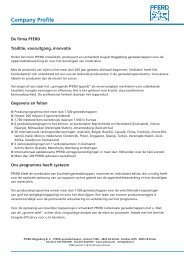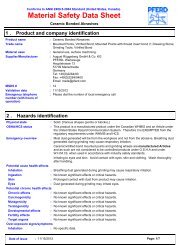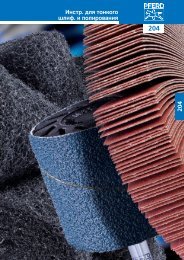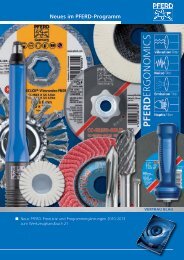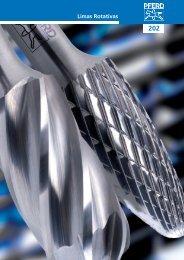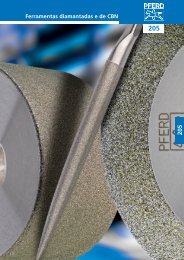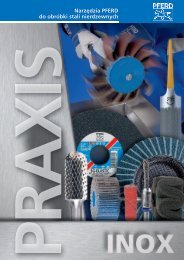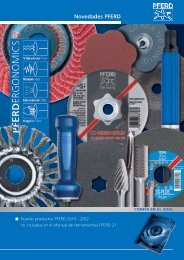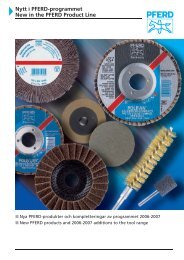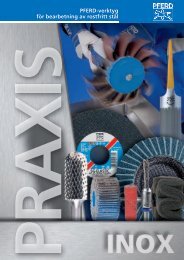Plastics PRAXIS - PFERD
Plastics PRAXIS - PFERD
Plastics PRAXIS - PFERD
You also want an ePaper? Increase the reach of your titles
YUMPU automatically turns print PDFs into web optimized ePapers that Google loves.
How long have plastics been around?<br />
We can no longer imagine life without plastics . During the 1950s/1960s, the material<br />
was considered to be the material of boundless possibilities and it started to move into<br />
people's everyday lives . They were delighted with the first colourful household goods<br />
made of plastic that came from America . Even the horrendously expensive silk stockings<br />
available at the time were replaced by affordable nylons . Iron-free shirts made<br />
of artificial fibres relieved the burden on housewives and went easy on the family<br />
budget . Plastic products became affordable, easy-care and almost indestructible massproduced<br />
goods . The versatility, colourfulness and durability of this modern post-war<br />
material stood for the attitude to life of a whole generation .<br />
Classic chair design from Verner Panton, made in 1960.<br />
Other materials such as steel, non-ferrous metals, concrete, wood, glass, ceramics etc .<br />
are being replaced more and more often by plastics . Increasingly efficient products<br />
are available on the market and accompany our everyday lives, e .g . in the fields of<br />
transport, logistics and traffic, leisure and sport, medicine and health, as well as communication<br />
.<br />
The plastic age has only just begun . New possibilities and new variants on these<br />
materials are being discovered every day . Their development potential is nowhere near<br />
being exhausted . If manufacturers manage to make the production process independent<br />
of crude oil, and optimise recycling ability and mechanical properties, plastics will<br />
rightly be known as the material of the 21 st century . The consistent use and further<br />
development in the sense of the comprehensive sustainability of plastics is the great<br />
challenge of the future .<br />
The original <strong>PFERD</strong> Tool Manual!<br />
<strong>Plastics</strong><br />
Material of the 21 st Century<br />
An old Bakelite telephone, made in 1950.<br />
As an independent material group plastics have a young history compared with metals<br />
and ceramics . The first formula for the production of a plastic material was noted in<br />
the year 1530 when casein was gained from goat's cheese . The subsequent centuries<br />
provide regular examples of the transformation of existing natural products into<br />
plastics .<br />
The industrial use of plastics did not begin until the beginning of the 20 th century,<br />
however . Since then, its technological and economic importance has been increasing<br />
all the time . This is mainly due to two factors:<br />
1 . Raw materials for the production of plastics can be gained from crude oil and/or<br />
biomass at low cost and are available world-wide .<br />
2 . The large variety of plastics available allows a broad range of properties and offers<br />
tailor-made solutions for different applications .<br />
The Airbus A380, made in 2007.<br />
With more than 7 .500 innovative solutions for surface finishing and material cutting .<br />
Request your own free personal copy at www.pferd.com .<br />
3


